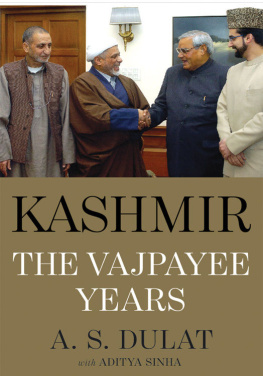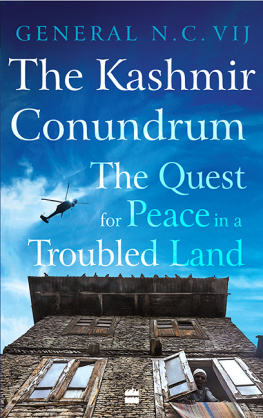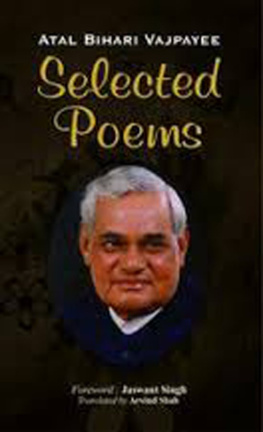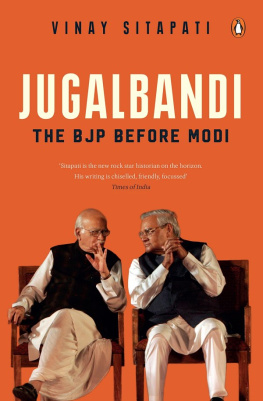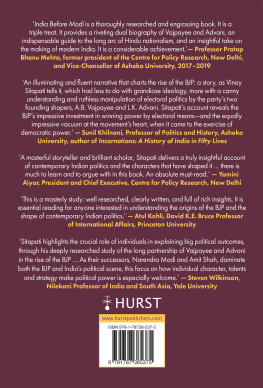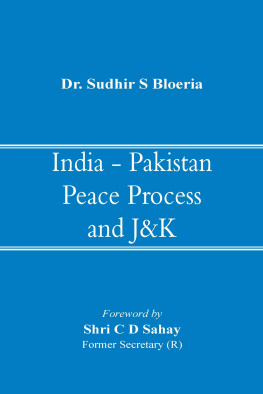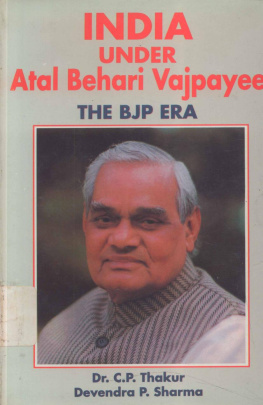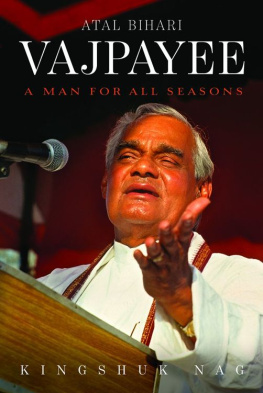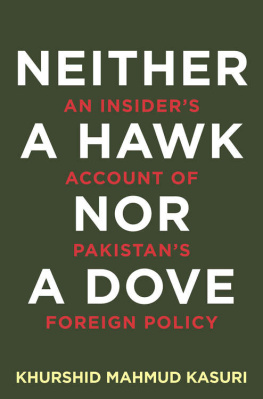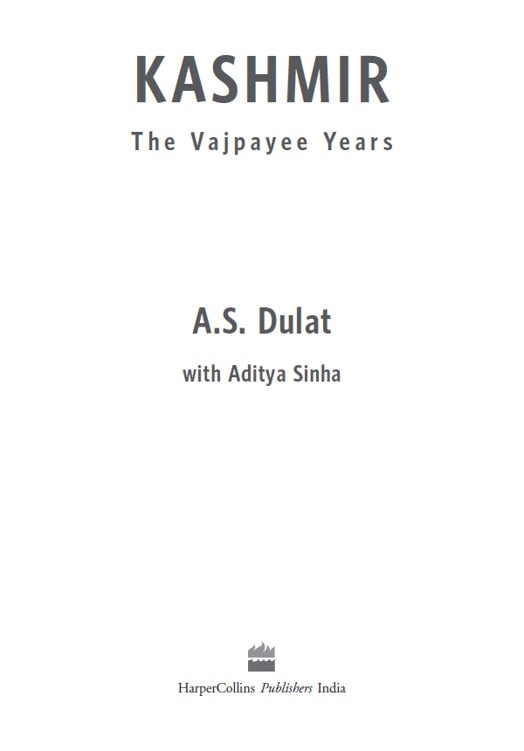Since this book is about Kashmir, Kashmir and Kashmiris must remain centre stage. Kashmir has been a huge education. I have learnt more in the last ten years since I left the government than when I was in the government and thought I knew everything. I am indebted for this education, which transformed itself into a story, to innumerable friends with whom I spent endless hours talking, discussing and learning about Kashmir. It is not possible to name them all, and many may prefer to remain anonymous. But to those who have been more indulgent I owe a huge debt: my friend, philosopher and guide who helped keep the flock intact during most trying times, Prof. Abdul Ghani Bhat; manager Ghulam Hassan Mir, who was a storehouse of knowledge but also simplified my understanding of Kashmir; the kind, gentle and underestimated Firdous Syed; the more mercurial Sajad, not only TV anchor Barkha Dutts favourite but mine also; the macho Hashim ever ready to take on both adversaries in Kashmir and even those across; Altaf, a businessman to his political fingers; Zafar, who everyone always thought was on the wrong side; Nadir, my ready reckoner; Prof. Riyaz Punjabi, who gave me my first lesson on Kashmir.
Agha SahibAshraf Aliwas the most remarkable human being I have ever come across. My education of Kashmir would have remained incomplete without his words of wisdom. That he was always indulgent towards me was my great fortune and I can never thank him enough.
How can one forget Dillu (Dilshad Shaikh), not only the most beautiful woman, but warm, hospitable and with the best table in Srinagar. As Aarooji once said, You havent seen the true beauty of Kashmir unless you have been to Gulmarg and met Dilshad Shaikh. Thanks, Dillu, for your affection and great food.
My family has been a pillar of strength. As with everything in my life, this would not have happened but for the inspiration of my wife, Paran. She, most of all, made me believe that I had a story that needed to be told. During the last year and more, she has been my confidante, private secretary and typist, apart from helping with the computer and internet, about using which I am still clueless. But above all she has been by my side at times of doubt when I have thought of chucking it all up in exchange for the mess I made of the house with papers strewn in every room. She also helped me gather photographs and recollect important events as we went down memory lane.
The Intelligence Bureau (IB) and the great institution of the Friday Meeting made men out of boys. Not just the dozen chiefs I had the privilege to serve under, but so many seniors from whom one learnt so much. In particular, M.K. Narayanan not only sent me to Kashmir but also tolerated me as a roommate during my first two years in the Bureau, which gave me an opportunity to see the master at work from close quarters and get my first whiff of intelligence. I am equally grateful to my colleagues in the K-group, each one a thorough professional, which made for an excellent team that made an impact in Kashmir.
A special thanks to my colleagues C.D. Sahay and K.M. Singh, with whom I had the good fortune of working closely. C.D. and K.M. not only helped put events and personalities in Kashmir in proper perspective but helped with the editing as well. My thanks to the Research and Analysis Wing for continuing its support to me during my term in the PMO.
Finally I must thank Krishan Chopra of HarperCollins for believing that I had a story to tell. Krishan could qualify as one of Smileys People for the way he led me up and down the alleys and staircases of Khan Market for our meetings. Thanks also to Rajinder Ganju, who provided valuable backup in taking the book through to press in a short time, and also took an interest in and appreciated the story in these pages.
Last but not the least, I must say a big thank you to boss, without whom there would have been no book. Aditya has been an old friend since the 1990s but when we began together (some would say he was the ghost writer but that somehow sounds spooky) as collaborators (not Ikhwanis in the Mirza Waheed sense!) he made it well known who the boss was and thats the only way it would have worked. Thanks, friend.
Aadaab. Baat Niklegi Toh Phir Door Talak Jayegi
Kafeel Azzer
One day during my tenure in the Prime Ministers Office (PMO)where I unexpectedly landed after my time heading the Research & Analysis Wing (R&AW) was upI was as usual discussing Kashmir with Brajesh Mishra, the principal secretary to Prime Minister Atal Bihari Vajpayee (who also served as Indias first national security advisor). Do you know, Dulat, the only thing straight in Kashmir are the poplars? he said.
Kashmir has been a part of my life since I first visited in 1987, in preparation for my posting there as deputy director in the Intelligence Bureau. The Kashmir Valley is beautiful all year round and its difficult to say which season is most beautiful. Spring, however, is special, with fruit blossoms, tulips, daffodils and narcissi. So even after retirement, come the Darbar move, Paran, my wife, and I still make our annual constitutional visit to Srinagar to savour the crispness of the air and a round or two of golf but most of all to catch up with old friends.
Paran thinks Im nuts, interacting with Kashmiris on an almost daily basis even ten years after I left the government. She herself is acquainted with many Kashmiri voices, literally: when I was deeply involved with Kashmir in the 1990s, our day in New Delhi normally began with a telephone call, which Paran would receive with an Aadaab. This was before mobile phones. In due course she recognised regular callers to whom she assigned nicknames: Tweedledee and Tweedledum, Beehive, Sidekick, Gingersnaps, Drone, Sleepyhead, Aap ka Bhai, etc. God knows how she came up with these names but we would laugh our guts out; it was the lighter side of what was a stressful period. Parans favourite was Gingersnaps, who was politeness personified.
In 2012 I was in Srinagar with Paran and six of her friends, and a regular visitor to our hut at the Centaur Hotel was Firdous Syed, a former militant commander-in-chief who went by the name of Babar Badr. The ladies were excited at meeting a militant and one of them, Sonia Pandhi, sacrificed a trip to Gulmarg to spend the morning listening to Firdouss story. How could such a decent person ever have been a terrorist? she asked me afterwards. I explained that Firdous was not a terrorist in the way she imagined one to be, but one of many disillusioned Kashmiris who took to the gun. More significantly, Firdous understood the futility of violence as early as 1994 when he wrote of his shattered dream, quoting Faiz Ahmed Faiz: Shishon ka koi messiah nahin, kyon aas lagaye baithe ho.
Reports of boys like Firdous coming and going to Pakistan began to trickle in as soon as I was posted to Srinagar in May 1988. There was no hint of this when I had come for my familiarisation visit six months earlier; at that time it all seemed like a holiday with a grand farewell party at Chief Minister Farooq Abdullahs residence for my predecessor K.P. Singh, who was on his way to the National Defence College, and we had vodka and kebabs by the fireside at Highland Park with Praveen Mahendru, a colleague, while it snowed outside during my first visit to Gulmarg. It all seemed like a picnic. Kashmir was at its glorious best. Soon I would also see it at its worst.

